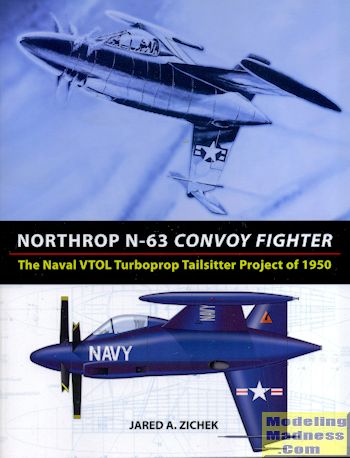 During the
last years of WWII and into the 1950s, the pace of aviation development was
staggering. Advances were coming so quickly that what was top of the line one
year, was nearing obsolescence just a few years later. It was also a time of
innovation where the military was not afraid to try something new and designers
were more than happy to stretch their abilities as well.
During the
last years of WWII and into the 1950s, the pace of aviation development was
staggering. Advances were coming so quickly that what was top of the line one
year, was nearing obsolescence just a few years later. It was also a time of
innovation where the military was not afraid to try something new and designers
were more than happy to stretch their abilities as well.
Such was the case of the Convoy Fighter. This was a plan to
allow ships in a convoy to carry a plane or two for self protection against
enemy bombers without the requirement for a large and expensive aircraft
carrier. The specifications called for a turboprop powered aircraft that could
land and take off vertically without the need for complex handling apparatus. It
should also be able to operate from a ship that was moving and so had to be able
to handle not only fore and aft movement but also side to side motion. These are
the motions that make most first time voyagers sea-sick.
Proposals were submitted by several companies and two were
chosen. These became the Convair XFY-1 and the Lockheed XFV-1. Both of these
planes flew, though only the Convair entry was able to take off and land
vertically. The main issue was the lack of power from available turboprop
engines and the difficulty of landing.
This book covers the third of the paper proposals, this time,
the Northrop N-63. The one was similar to the others in that it would be powered
by an XT-40 turboprop and it was designed to be a tail sitter, so would not
require any special handling equipment, unlike the Martin proposal. The aircraft
was the usual stubby design and had short, straight wings with the guns in wing
tip pods, which seemed like the standard for these planes.
Northrop went several steps farther than the other proposals
by offering proof of concept prototypes prior to going on to the main design.
There were actually two of these POC aircraft, one very similar to the end
result and another on conventional landing gear with the tail section somewhat
reversed to the final product. Naturally, these additonal POC aircraft raised
the overall cost of the project considerably, but Northrop also provided options
without them and in fact recommended not using them. Northrop also did some wind
tunnel testing with models to help smooth out the design and passed that
information along to the Navy prior to decision making. Still, the project would
have been expensive and like the other rejected projects, was determined by the
Navy to be heavier than projected and for this reason, as well as their
hesitancy to deal with Northrop, based on their experience before the war with
the BT-1, pretty well killed what looked like one of the more viable options.
In this book, the author covers every known aspect of the
Northrop N-63 project including a wealth of engineering drawings of the aircraft in
question along with the original and updated brochure offered by Northrop. There are also artists impressions of these aircraft as well as full
color profiles of what might have been. It makes for a fascinating look into
what might have been and sheds some light on a little known aviation project.
November 2015
My thanks to
www.retromechanix.com for providing the review
sample. You can get yours
here.
If you would like your product reviewed fairly and fairly quickly, please contact
the editor or see other details in the Note to
Contributors.
Back to the Main Page
Back to the Books Index
Page
 During the
last years of WWII and into the 1950s, the pace of aviation development was
staggering. Advances were coming so quickly that what was top of the line one
year, was nearing obsolescence just a few years later. It was also a time of
innovation where the military was not afraid to try something new and designers
were more than happy to stretch their abilities as well.
During the
last years of WWII and into the 1950s, the pace of aviation development was
staggering. Advances were coming so quickly that what was top of the line one
year, was nearing obsolescence just a few years later. It was also a time of
innovation where the military was not afraid to try something new and designers
were more than happy to stretch their abilities as well.